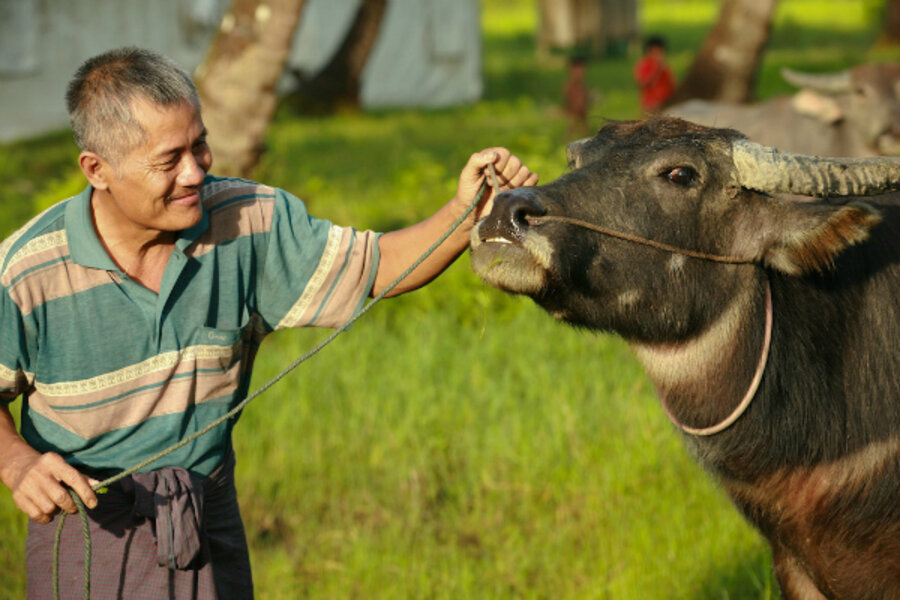Cash cows: Why bank accounts that work like livestock help the poor
Loading...
In an age of mobile banking and digital transactions, many poor people still shun basic banking services and put their extra money in livestock. Why?
Cows make sense as a savings account, says Ignacio Mas, a senior fellow at the Fletcher School's Center for Emerging Market Enterprises at Tufts University.
People want to put money away in a place where they cannot immediately spend it. Like a certificate of deposit, a cow or other livestock fits this need. A cow also produces milk and fertilizer, which families can sell. It may give status to the owner, or be a religious symbol.
But a recent Yale University study found that poor Indians lost 9 percent to 64 percent of their livestock investment.
"The poor are often willing to earn negative interest to access reliable savings services," wrote Nathalie Tadena in The Wall Street Journal.
If using a savings account worked more like a cow, poor people might be more willing to put their money in a bank, says Mas. Banks and telecom companies must tailor accounts to suit the needs of poor clients, Mas says, adjusting programs so that poor clients can truly plan for a more secure future.
In short, banks should create accounts that act like cows.
Mas lays out seven ways a cow can help poor people restrict spending and save:
- A waiting period – the cow can’t be sold immediately
- Indivisibility – you can’t sell only a leg
- A financial penalty – there are costs involved in buying and selling a cow
- Mental labeling – the cow invites clear associations to what people save for
- Perceived production – the cow’s milk production raises the mental stakes of selling it
- Peer pressure – the whole town will know if you sell a cow, and everyone may question your financial judgement and start asking to borrow money
- Social meaning – cows can represent deep cultural beliefs, divinity or fertility or completeness of family
A cow, a gold necklace, or a penny jar labeled “education” all have different limitations when they serve as saving accounts. However, poor people could benefit from safer and more stable ways of building financial security than physical items that may lose their worth or risk being stolen.
The poor don’t need simple banking tools, they need intuitive tools, Mas explains. The poor have many financial needs and inconsistent income, creating complex financial lives. Tools need to reflect those complexities to help the poor reach their goals.
Bank account restrictions will fail if users don’t understand them, according to Mas. "The account rules seem like an arbitrary imposition, you have to learn them, and you feel cheated when you get caught by a friction you didn’t remember. Not so with the cow."
When a poor person needs money and an account rule stands in the way, it seems arbitrary and unnecessary. Intuitively it makes sense why they can’t take cash out of a cow or only sell a portion of it. If a poor person recognizes “cowness” in a bank account, argues Mas, then she will be more comfortable using it.
Mas suggests several ways banks and telecoms can tweak policies to help the poor use bank accounts more intuitively:
- Name accounts to mirror their restrictions. A “chicken,” “goat,” and “cow” account would only allow certain amounts of withdrawal. Say, $10, $30, and $100 respectively.
- Name accounts for different goals, like “education” or “new plow.”
- Add restrictions to accounts to encourage saving. Allow withdrawal only on certain days of the week or for certain activities. The “Friday” account only allows withdrawals on Fridays.
- Have a moneyguard for an account. Your money goes into a friend’s subaccount, but the only thing he can do with it is send it back to you. Peer pressure will help keep you from spending it unwisely.
Banks need to meet the poor's needs through the products they create and how they advertise them. If the poor become comfortable using better formal saving options, an actual bank account can take the place of a cow.
• Reporting from this post is partially based on conversations from the Center for Effective Global Action's mobile money conference, hosted at The University of California at Berkeley in September. Further coverage of the conference can be found on Next Billion's Financial Innovation blog.
• This article originally appeared at Global Envision, a blog published by Mercy Corps.





